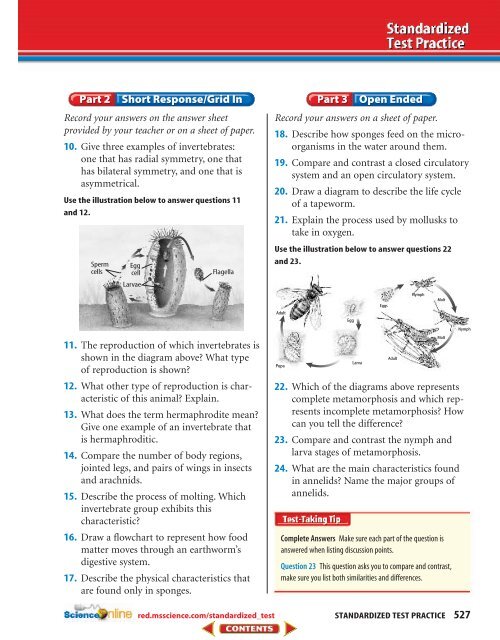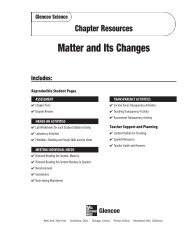Chapter 17: Invertebrate Animals
Chapter 17: Invertebrate Animals
Chapter 17: Invertebrate Animals
You also want an ePaper? Increase the reach of your titles
YUMPU automatically turns print PDFs into web optimized ePapers that Google loves.
Record your answers on the answer sheet<br />
provided by your teacher or on a sheet of paper.<br />
10. Give three examples of invertebrates:<br />
one that has radial symmetry, one that<br />
has bilateral symmetry, and one that is<br />
asymmetrical.<br />
Use the illustration below to answer questions 11<br />
and 12.<br />
Sperm<br />
cells<br />
Egg<br />
cell<br />
Larvae<br />
Flagella<br />
11. The reproduction of which invertebrates is<br />
shown in the diagram above What type<br />
of reproduction is shown<br />
12. What other type of reproduction is characteristic<br />
of this animal Explain.<br />
13. What does the term hermaphrodite mean<br />
Give one example of an invertebrate that<br />
is hermaphroditic.<br />
14. Compare the number of body regions,<br />
jointed legs, and pairs of wings in insects<br />
and arachnids.<br />
15. Describe the process of molting. Which<br />
invertebrate group exhibits this<br />
characteristic<br />
16. Draw a flowchart to represent how food<br />
matter moves through an earthworm’s<br />
digestive system.<br />
<strong>17</strong>. Describe the physical characteristics that<br />
are found only in sponges.<br />
Record your answers on a sheet of paper.<br />
18. Describe how sponges feed on the microorganisms<br />
in the water around them.<br />
19. Compare and contrast a closed circulatory<br />
system and an open circulatory system.<br />
20. Draw a diagram to describe the life cycle<br />
of a tapeworm.<br />
21. Explain the process used by mollusks to<br />
take in oxygen.<br />
Use the illustration below to answer questions 22<br />
and 23.<br />
Adult<br />
Pupa<br />
Egg<br />
Larva<br />
22. Which of the diagrams above represents<br />
complete metamorphosis and which represents<br />
incomplete metamorphosis How<br />
can you tell the difference<br />
23. Compare and contrast the nymph and<br />
larva stages of metamorphosis.<br />
24. What are the main characteristics found<br />
in annelids Name the major groups of<br />
annelids.<br />
Eggs<br />
Adult<br />
Nymph<br />
Complete Answers Make sure each part of the question is<br />
answered when listing discussion points.<br />
Question 23 This question asks you to compare and contrast,<br />
make sure you list both similarities and differences.<br />
Molt<br />
Molt<br />
Nymph<br />
red.msscience.com/standardized_test<br />
STANDARDIZED TEST PRACTICE 527














